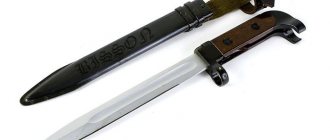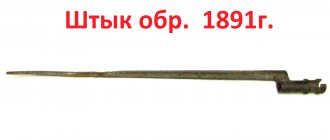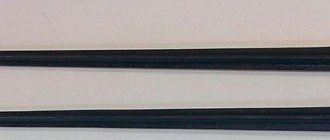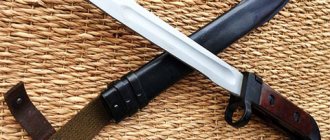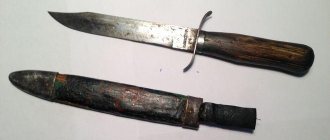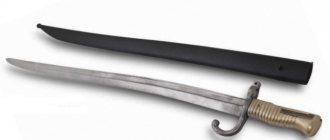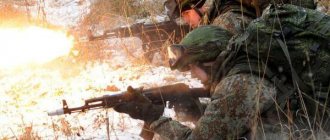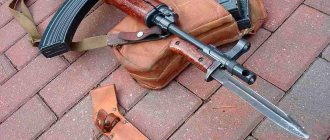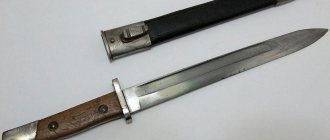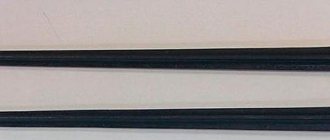The Kalashnikov assault rifles, adopted for service in 1949, were not equipped with bayonets. But since the military often used the machine gun in battle as a strike weapon, it was soon decided to develop a high-strength blade that could be fixed to the barrel. The AK-47 bayonet was produced along with the machine gun. It was first modernized only after the creation of the AKM. Subsequently, the model was refined several times. Numerous photographs confirm this fact. Different types of devices differed in technical characteristics.
The bayonet knife was used in close combat.
Design Features
The first bayonet was called a 6x2 product. It was put into service in 1955. Despite the fact that in the drawing the model looked like a bayonet, the design made it possible to use it as an army knife.
Since the first machines did not provide for the installation of additional devices, they had to be modified during scheduled repairs. Design features of the model:
- Single-edged blade. It had the shape of a spear and was equipped with fullers to facilitate the design.
- Riveted handle. Plastic covers were attached to it with a pair of screws.
The device was firmly fixed on the trunk:
- On the muzzle using a ring on the cross.
- On the stop of the gas chamber there is a T-shaped groove with a spring latch located in the head of the handle.
The total length of the bladed weapon is 315 mm, blade dimensions are 205x22 mm. Additionally, the bayonet-knife was equipped with a steel sheath. They were equipped with a loop and a strap for fixing on the belt.
Story
Bayonets have an extensive history. Thus, for the first time such a weapon was installed on the Berdanka in 1870 - a single-shot rifle with a central ignition cartridge. But soon the impractical trihedron was replaced with a more durable tetrahedral needle-shaped one. A little later, this version ended up on the Mosin rifle. The bayonet knife was used with her in the First and Second World Wars, the Civil War and the Russo-Japanese War.
The versatility and convenience of the “Russian” melee weapons frightened their enemies, because when the soldiers’ magazines were empty, they fearlessly went into battle with a butt and a bayonet, delivering blunt and piercing blows.
There are several modifications of the product attached to the Mosin rifle: using a clamp, using a latch with a spring, or in the same way, but with a muzzle.
After the conclusion of the Balkan Union, in 1912, 50 thousand rifles with bayonets were sold to Bulgaria, and 2 years later the Serbs became interested in the weapon.
However, after the First World War, soldiers noted that bayonet knives sometimes got in the way, gave away their presence in a trench or in the forest, and made the rifle barrel heavier. Thus began gradual work on their modernization. In 1944, a three-line carbine with an updated version of the needle bayonet, which was thrown out when necessary, entered service.
Today, according to current legislation, a bayonet-knife is considered a bladed weapon only when attached to a rifle or carbine.
Prototype of a modern AK bayonet model
The prototype of the first bayonet is a device developed for the SVT-40. This Soviet weapon was used in the USSR army from the first days of the Great Patriotic War.
The length of the prototype bayonet is 360 mm. The parameters of a single-edged blade with fullers on both sides are 240x24 mm. Other design features:
- The tip has a double-sided sharpening.
- The handle has two wooden cheeks. They are secured to the shank with a pair of rivets.
- The sheath is made of steel, equipped with a spring-loaded mouth and two suspension brackets.
For fixation on the barrel of the weapon, a ring installed on the side of the butt and a T-shaped groove with a spring latch on the head of the handle were used. There was a safety collar next to the button. The simple design ensured reliable fastening.
Varieties
All armies of the world began to supplement firearms with cold steel. Along with improving machine guns and rifles, gunsmiths also worked on improving the designs of bayonet knives. Models of triangular blades and folding blades are known.
All modifications can be divided into the following groups:
- double-sided sharpening;
- T-shaped section, double-sided sharpening;
- one-sided sharpening;
- stiletto, needle-shaped blade.
There are different ways to attach a cold accessory to a weapon - a ring, a groove, a latch. The places where the fastener is attached also differ - the cross or the base of the knife handle.
Modernization of the AK-47 bayonet
Modernized Kalashnikov assault rifles (AKM) were put into service in 1959. They were equipped with a new bayonet, which was called the 6x3 product. The total length of the bladed weapon was 280 mm, while the dimensions of the single-edged blade with a double-edged sharpening of the beveled combat end were 150x30 mm.
A modified version of the bayonet.
Thanks to the change in size, the device has become more convenient to use compared to the previous version. There are fewer differences between AK and AKM than in bayonets for these machine guns.
The design of the modernized device made it possible to deliver piercing and cutting blows during hand-to-hand combat. To solve additional problems, there was a rectangular hole in the middle part of the blade, and notches were made on the butt.
To make the sheath, a metal tube with a rectangular cross-section was used. A wide rubber pad was installed in the part adjacent to the handle.
During work operations it could be used as a handle. On the lower part, a metal part was fixed with rivets, serving as an additional blade. It had an axis for installing a knife.
Thanks to this design, edged weapons have become a universal cutting tool. In it, the main edge and the serrator on the butt were used for cutting various materials. By connecting a bayonet-knife to a scabbard on a T-shaped support, it was possible to obtain wire cutters. They could be used to organize passages through enemy wire barriers.
After some time, a 6x4 bayonet knife model appeared. Initially, it was also used for AKMs, and later the AK-74 was equipped with such a device. The blade in the model remained the same, the handle was modernized - it became more ergonomic.
The sheath was made of high-strength plastic. The 6x4 bayonet knife was modernized several times, but this had virtually no effect on its appearance. The total length was 270 mm and the weight was 250 g.
In 1989, an experimental model was developed for AK-74 assault rifles. It is believed that it became the prototype for the modern version.
The blade without a cut had a symmetrical spear-shaped combat end, which was distinguished by double-sided sharpening. The blade is thicker, but has been beveled to provide a thinner tip.
Experimental melee weapons were soon replaced by new versions. Today it can only be found in private collections. Modified souvenir models also appeared. These are ShNS bayonet knives, which differ from the original. Sometimes you can find folding models, but they are not considered real melee weapons.
Experimental versions can only be seen in collections.
Bayonet AK 74 6x5 modern model
In the process of the long evolution of the product, until 1986, an innovative product appeared - a 6x5 bayonet for the AK 74 and its brother AK 74M. The development of production and the development of the new PA-6 polyamide allowed designers to replace parts of the body kit on machine guns and light machine guns. The AK 74 6x5 bayonet was also not spared. There are three versions of them, let's look at each in more detail.
Bayonet AK 74 6x5 first version
The primary objectives for the designers were: reducing the cost of production and improving the performance characteristics of the product. The 6x5 bayonet has an original design, radically different from previous models. According to the documents, it looked like a simplified model.
The main difference from previous cutters was the spear-shaped shape of the blade and the absence of an oval hole near the tip. It was intended to cut through the wire when connecting to the scabbard. Another solution for such manipulations was used.
The scabbard had a hole in the bottom through which the tip of the blade was threaded. The result was wire cutters, but this solution was not developed. The design was tested in airborne units during the war in Afghanistan. And in combat conditions it became clear that the previous version of the instrument was more reliable and convenient.
On the left is the AK 74 6x5 bayonet of the first sample, on the right are the subsequent ones.
The handle of the bayonet for the AK 74 6x5 was transformed, the latch button was placed on it and the steel tip on the pommel was removed. The strap was excluded as unnecessary. During manufacturing, the blade was tightly fused to the handle with polyamide. The file on the cutter was located in the same place, but with simplified teeth. The length of the wedge has increased by 10 mm.
Bayonet AK 74 6x5 second modification
Information about the problematic design solution with wire cutters quickly reached the developers. Already in 1987, the 6x5 bayonet received a hole at the tip. The handle has acquired a more ergonomic shape. There are special recesses in the guard area.
The second version is dark cherry color.
They prevent the polyamide from rubbing off when the bayonet is carried in a sheath. The blade remained spear-shaped and the same length. We lengthened the file, its length almost to the hole along the cutting edge. Today the AK 74 6x5 bayonet of the second type is quite rare. Its rapid modernization into the next generation contributed to this phenomenon.
AK 74 6x5 bayonet third and final option
Production of the 6x5 bayonet in the third type began in 1988. The blade has not received any changes in this modification. The reconstruction touched the handle. It has become more ergonomic and grippy thanks to an increase in the hollows under the fingers and a change in their radius to a smaller side.
The first products were marked with a serial number at the bottom of the handle. In later versions it was moved closer to the blade. There are bayonets for AK 74 6x5 with a rough handle; they belong to the early varieties of products.
Pistols... with bayonets
Any new product is usually used until it is “torn to pieces.” A similar story happened with bayonets. They also began to be installed on pistols, and even on... machine guns. But today we will start with pistols and... revolvers, for which special bayonets were also invented! He pulled out a pistol
Like himself, just as plump, And he brought the six-barreled barrel towards the wanderers: “Don’t move!
If you move, Robbers! robbers! “Who Lives Well in Rus'” N.A. Nekrasov History of weapons.
Articles about bayonets aroused great interest among the VO readership, and this is not surprising. After all, it was indeed a very effective weapon, and it had been that way not for years, but for centuries! And just how many kilometers of intestines have been perforated with bayonets and wound around bayonets, it would probably be quite enough to cover the distance from the Earth to the Moon and back.
However, in the process of writing these articles and delving into the material itself, one very interesting thing became clear, namely, that the use of bayonets took place not only in long-barreled weapons, but also in short-barreled weapons with an important purpose... to add versatility and lethality to it.
The bayonet on the gun originally appeared to serve as protection for the infantryman from the horseman. Many infantrymen could bristle their bayonets so much that the horsemen simply would not dare to attack them, since this would mean certain death for them. And only over time, as the art of war, so to speak, developed, did the military understand that the bayonet can serve not only as a means of defense, but also of attack, and that bayonets can kill not only horses, but also people. And there is nothing easier at all to finish off prisoners or wounded people with them, and then who will be there to figure out where and how the enemy was stabbed to death - standing up or already lying on the ground.
And it is clear that, seeing such a high efficiency of the bayonet, pistol manufacturers immediately tried to adopt it. When pistols were wheeled and expensive, there were no bayonets yet, but when they appeared, flintlocks became widespread, which immediately noticeably reduced the cost of pistols. And if horsemen, as well as officers in the infantry, did not need pistols with bayonets, since both of them made do with either just a sword, or a saber and a pike, then civilians really liked such an improvement. After all, having fired a pistol once, the person armed with it found himself completely unarmed and had to either load it in a hurry, or run away from his opponent, or surrender, giving up his wallet, or even his life. Well, a pistol with a bayonet made it possible to grapple with the same robber hand-to-hand and hit him, if not with a bullet, then with a bayonet!
Set of pistols (photo by Alain Daubresse)
Many pistols equipped with bayonets were produced by British gunsmiths. Here, for example, are a couple of pistols produced by . These are seven-inch long flintlock pocket pistols with needle bayonets and .52 caliber smooth barrels. The bayonets are on the trunks on the right. They can recline and lock in this position. The triggers are also designed to be foldable, making them easier to use. The walnut stocks are inlaid with engraved silver flowers and wire scrolls, and feature engraved overlays that read "Mortimer and Son."
John Richards' three-barrel rifled pistol (photo by Alain Daubresse)
It is clear that two barrels on a pistol are better than one, and three are better than two. But such pistols were difficult to produce and maintain, and therefore expensive. However, for example, in 1790, the London company of John Richards even released a three-barreled pistol with rifled barrels, ensuring accurate combat, and also with a bayonet, which also folds out if necessary.
Two barrels are of a larger caliber, the third is the lower one, has a smaller caliber (photo by Alain Daubresse)
The pistol is very miniature. However, the lowermost barrel of a smaller caliber is equipped with a triangular spring bayonet. The box lock with engraved panels is inscribed: J. RICHARDS LONDON. It has a position lever for switching the ignition of charges in the barrels (on the left), and there is also a safety lock behind the trigger. The gun really looks like a toy, but it can easily kill a person, especially if you shoot him at point-blank range and gouge out his eye with a bayonet.
Still from the animated film “The Adventures of Pinocchio” (1959). As a child, I really liked this cartoon, but for a long time I considered the Cat and Fox pistols shown in it to be the artist’s invention... But no, it turns out there were such pistols!
Here's a gun that came straight out of a fairy tale. The barrel is .78 caliber, barrel length 130 mm, engraved “W. BOND" and even the specified address. The bayonet is needle-shaped, folding, located at the bottom, so the ramrod mount is on the right.
V. Bond's pistol (photo by Alain Daubresse)
This photo clearly shows the bracket with which the pistol could be attached to the waist belt! (photo by Alain Daubresse)
Another pistol with a barrel of terrifying diameter and, of course, a bayonet! This time made in France (photo by Alain Daubresse)
Potts pistol
As soon as capsule pistols appeared, bayonets appeared on them. For example, the bayonet had a .32 caliber Potts pistol. It had two barrels located vertically, two triggers, two triggers and two fire tubes shifted accordingly in relation to the barrels.
The 10mm Spanish bayonet pistol had two barrels positioned horizontally and a folding bayonet in the hollow between them! (photo by Alain Daubresse)
Barrel block mounting mechanism (photo by Alain Daubresse)
A pistol-dagger with vertically positioned two barrels of 0.41 caliber (10.4 mm) chambered for rimfire cartridges and... a non-retractable bayonet between the barrels, according to a patent of 1868, was also produced by Frank Wesson’s company. The barrels on it were turned manually. The descent is nipple. By the way, the six-barreled pepper grinder revolver, with which the plump merchant frightened the peasants from the villages “Gorelova, Neyolova - Unharvest, etc...”, could well have had a non-removable and non-retractable bayonet-pike located in the middle between the barrels; such models are also known.
Well, when the era of classic revolvers with one barrel and a drum arrived, bayonets appeared on them. For example, an advertisement for a Francotta revolver with a bayonet is simply absolutely terrifying! (photo by Alain Daubresse)
Hairpin revolver manufactured by P. Stephens (Maastricht, Netherlands) with an under-barrel folding bayonet. Caliber 11 mm, length 27 cm (photo by Alain Daubresse)
Moreover, bayonets on short-barreled firearms were installed not only on civilian models, but also on service ones. For example, Nagant M.1884 7.5 mm revolvers, which entered service with the Luxembourg gendarmerie, were equipped with removable bayonets!
Gendarmerie revolver "revolver" M.1884, Luxembourg (photo by Alain Daubresse)
During the First World War, there was a need for portable weapons for fighting in the trenches. Rifles and even carbines were not suitable for this. The soldiers went on the attack with grenades and sharpened sapper blades, others armed themselves with axes or homemade clubs studded with nails. The Pritchard bayonet, mounted on a .455 caliber Webley Mark VI revolver with a standard 6-inch barrel, would solve this problem.
Webley MK VI Pritchard bayonet revolver. Designed by Lieutenant Arthur Pritchard of the 3rd Royal Berkshires (photo by Alain Daubresse)
The bayonet had a special brass handle to which was attached the front of the French Gra M.1874 rifle bayonets with a "T" cross section, which were very available during the First World War.
Webley-Pritchard revolver with bayonet on the barrel (photo by Alain Daubresse)
The design of the bayonet was such that it did not interfere with aiming, while the end of the handle had a special recess for the barrel hinge on the revolver frame. Thanks to this, the revolver could be freely reloaded without removing the bayonet.
The crossguard was provided with a locking latch, which was located directly behind the front sight mount and held the bayonet on the weapon. In addition, this revolver, along with a bayonet, also came with a butt, which essentially turned it into a lightweight six-round large-caliber carbine, very rapid-fire, and also with a bayonet!
To be continued…
Latest Developments
In 2010, a mock-up and then a sample of the Shmel bayonet appeared. The original model has an asymmetrical double-edged blade and a rubber handle. It has six grooves, which guarantees a secure grip. Textolite was used to make the sheath. The set includes a sharpening stone. Fixation is traditionally done using:
- a cross with a ring, which is installed on the blade side;
- T-slot with spring latch on the head of the handle.
The Russian 6X9-1 bayonet is a component of the Ratnik combat equipment. When creating it, a titanium nanocomposite coating was used. Thanks to special processing, unmasking glare is reduced.
Bayonet knife 6x9.
The cutting edge is distinguished by differentiated double-sided sharpening. Short fullers reduce the weight of the model. The sheath is made of impact-resistant plastic. They have a mechanism that allows you to cut through steel wire. Additionally, a diamond stone is installed for straightening the cutting edge.
Practical use
Various operations are performed using a bayonet knife. If necessary, it can easily be converted into the following tools:
- hammer;
- wire cutters;
- scissors;
- saw;
- screwdriver
At the bottom of the sheath, the corner of the plastic has a rough cut. Using it, you can light a match or strike a spark from a mineral stone with one movement.
Using melee weapons you can create a spear. All you need to do is find a suitable shaft and attach a bayonet-knife to its end. This device is convenient to use for hunting and fishing.
Using a special clamp that fits onto a metal protrusion in the sheath, the bayonet-knife can be used as a torch. The oiled cloth is fixed to the structure and can be used without the risk of burning your hands.
Requirements for edged weapons
Since an AK bayonet is a bladed weapon, according to the law, intelligence officers have the right to carry it when performing their official duties. In all other cases, permission is required. It can be received by:
- citizens whose activities are related to hunting;
- military personnel who received the item as a trophy.
Violation of the rules is subject to confiscation of the item and an administrative fine. Melee weapons must be stored in a case and in a closed place specially designed for such purposes.
Previous
Combat knivesCombat knife "Caiman" - a dangerous dagger in the hands of a scout
Next
KnivesSelf-defense against a knife - basic techniques and their effectiveness
Rifle bayonet: history of development
The bayonet weapon is a direct descendant of the combat pike, which in turn is the last round of the evolution of the spear. Before the advent of the first firearms, edged weapons were the main weapon of infantry. When entire detachments armed with muskets appeared, edged weapons gradually began to lose their position. But since the musket needed a long reload, detachments of pikemen were given to help the musketeers. The life of a soldier with a pike was short, since he could only fight in close combat, so these units gradually disappeared.
Since after the shot the shooter found himself practically unarmed, he needed a specific weapon that would not interfere with his ability to wield a firearm. This is how the first samples of baguinettes appeared - long blades that were inserted directly into the barrel of a musket. This weapon interfered with reloading, but in the conditions of a fleeting battle it coped well with its duties.
In 1699, the first bayonets appeared, which did not interfere with the reloading process at all. Soon these weapons almost completely replaced pikes from the battlefield.
